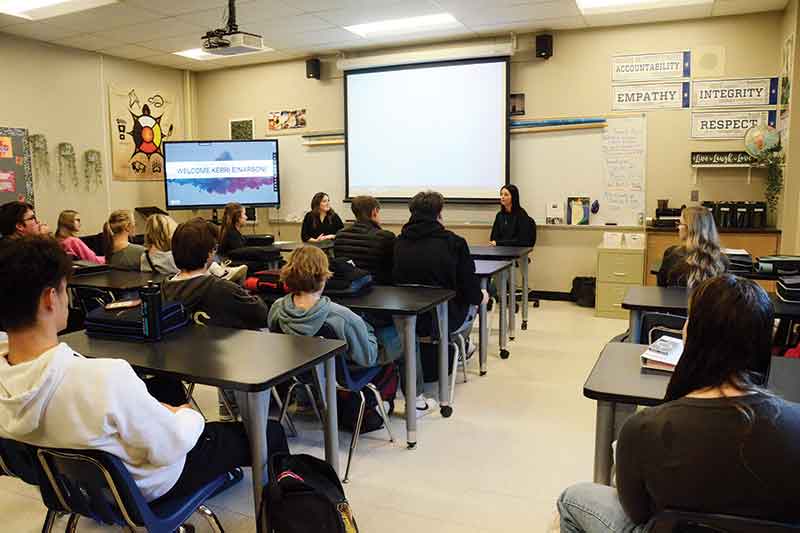Students learn how professional athletes learn mental and physical toughness
Professional curler, Kerri Einarson shared her knowledge competing on the national and international stage with a group of Lord Selkirk Regional Comprehensive Secondary School students last week. The informative question and answer session for Samantha Russell’s sports psychology class had Einarson sharing personal stories, some strategies she uses when in high-pressure situations and her thought processes in high pressure circumstances.
She started off by sharing her background in sports and how she started on her path to becoming a professional athlete.
“I started curling when I was eight years old, and it was always something I was interested in doing. My uncle was world champion and I really looked up to him so when I saw him win the Brier and then win the worlds I knew right away that was something I wanted to do,” said Einarson.
She is a Comp Alumni and has been curling for about 27 years.
“When I step on the ice I’m just like a totally different person. I’m just in the zone and it’s a pretty amazing feeling,” said Einarson.
Being a professional athlete is an important part of her life but we all have many aspects of ourselves that we need to balance. Balancing her home life and the sport that has become her career is something that Einarson spoke to the class about.
“I recently just quit my job about a year ago to be able to focus on curling and be able to be at home with my family. I found that was really challenging to be able to juggle my work life, my family life and my curling. I would get off a plane at midnight, not get home until 1:30 in the morning, and then get my girls up in the morning, off school and I was off to work. It was really draining,” she said.
Dealing with pressure and stressful situations is something that someone competing on Einarson’s level knows well.
“At first, it was hard. Being on TV for the first time, like oh, yeah, I was just shaking. It was tough but when you’re doing it all the time and getting yourself in big pressure situations you get more relaxed and used to it,” she explained.
Some techniques she mentioned using were breathing exercises to slow her heartrate and having a routine when she goes to make a pressure shot already in place so that she’s going at a slower pace.
Einarson then took the class through some video clips of her at a previous Scotties Tournament of Hearts bonspiel.
She talked about a situation where she made a momentum changing shot where she felt that change and how she used that energy to propel her and her team forward. She mentioned “celebrating the simple shots,” as a way to keep positive energy up.
She also discussed a shot she missed saying, “I gave myself 30 seconds to be absolutely [upset]. My self-talk is like ‘Kerri you have to be better.’ My self-talk isn’t always nice but it’s just something that I do to motivate myself to be like, ‘No, you can do this,’” said Einarson.
She explained that losses are an important part of sport because you learn from them and then you carry that knowledge forward.
Einarson finished the discussion by giving the students some tips for when they find themselves in high pressure situations that work well on the ice and off.
“It’s okay to miss, you’re human. It’s okay to mess up. It’s just part of the game. We’re not perfect. It happens so don’t be so hard on yourself. Knowing to forgive yourself and be like, ‘Hey, I’ll give myself like 30 seconds to be mad,’ and get over it and move on. That is something that I’ve worked extremely hard on and I think that I’m really good at that I can pull myself out pretty quickly,” she said.

